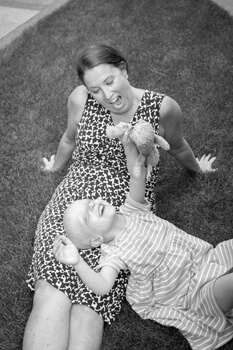NewsMay | 16 | 2019
Belle's Story: Where Putting the Patient First Creates a Holistic Approach to Care
Belle Swersey, 4, sat on the edge of her bed in Infusion Room 3, arms crossed and not in the best of moods. The chemotherapy was taking a toll on the usually bubbly and energetic preschooler. Heather Peach, MS, CCLS, a child life specialist in the Pediatric Hematology and Oncology Unit, sensed Belle’s frustration and laid out needleless syringes filled with paint and an assortment of bed pans. On the count of three, she and Belle pressed the plungers on the syringes, sending streaks of paint onto the bed pans until Belle’s bright smile and infectious giggles returned.
“It was like Jackson Pollock to a bed pan,” said Belle’s father, Jonathon.

This past February, Belle was diagnosed with stage 4 embryonal rhabdomyosarcoma in her jaw, an aggressive childhood cancer that affects muscle tissue and bone. Her parents, Jonathon and Julie, of Newton, Mass., brought her to Mass General for Children (MGfC) in June to receive chemotherapy and proton beam therapy, a targeted form of radiation that helps shrink tumor cells while helping to preserve surrounding healthy tissue.
Focusing on the child first instead of the diagnosis is the standard of care at MGfC and it’s what makes a world of difference for patients and families. “We see the child first, not the disease, not the diagnosis,” said Peach. “We see it as the child who has cancer, not ‘the cancer patient.’ We meet children and families where they are to support their needs, including the medical, emotional and psychosocial impact of this cancer diagnosis.”
Whether it’s learning skills to cope with emotions through creative outlets, like syringe painting, or building trust by first doing physical exams on Ninny, Belle’s stuffed lamb that accompanies her to the hospital, the focus of her care is always Belle first.
“MGfC provides a care team for each child that includes primary nursing, a primary physician with expertise in the child’s particular cancer and primary nurse practitioners. Our team is readily accessible and small enough to allow fantastic continuity of care, while also large enough to have ample experience treating all childhood cancers and providing a full range of resources available at a world-class hospital,” said Alison Friedmann, MD, a pediatric oncologist and member of Belle’s care team.”We also have fabulous ancillary services to help support the child and family throughout treatment and beyond, including on-site child psychiatry, social work, child life, music and art therapists and supportive therapies, like massage therapy, acupuncture and acupressure.”
For Peach, quality of life programming, such as John Hancock Child Life and Wellness Services, is an important part of a patient’s treatment journey. “That’s what it is, really. A journey,” said Peach. “There are the platelets, the chemo, the radiation, but there’s also listening, playing and offering opportunities to build confidence. We help children develop life-long coping skills, which will have a positive impact throughout their treatment as well as in the home and school environments.”
For Belle, this meant arts and crafts that help her express her emotions. “Belle is a bright, inquisitive girl who loves anything messy, like paint or clay,” said Peach. “If she’s sad, happy, frustrated or just needs to be silly, recognizing and validating those emotions through play are what we focus on for the day.”
In addition to the John Hancock Child Life and Wellness Services, the Swerseys believe having a primary nurse for their daughter made coming to the hospital a more positive experience. When Belle comes in for chemotherapy, Rhonda McIntyre, RN, CPON, Belle’s primary pediatric oncology nurse, does her best to reserve her favorite room, Infusion Room 3. When Belle checked in for her appointments, McIntyre would also post a sign on the door, stating “Belle’s Room.”
“Making Belle and her family feel comfortable and letting her know she’s important is a vital piece of her medical treatment,” said McIntyre, who also serves as a listening ear and pillar of support for families like the Swerseys during difficult times. “Belle’s family was understandably anxious in the beginning, but they knew they could reach out to me or anyone on Belle’s care team at any time. In my years of experience, families who are able to cope and form positive relationships handle treatments much better.”
With six weeks of chemotherapy and proton beam therapy behind her, Belle’s overall health has improved on many levels. “Putting the child first is built into the model of care here. It starts and ends with the child,” said Jonathon. “It’s a more holistic model and, in a way, you could say it’s a new form of ‘personalized medicine’ that makes all the difference.”
Type
Centers and Departments
Topics
Exceptional Pediatric Care
A new model for children's health care: learn more about Mass General Brigham for Children.

